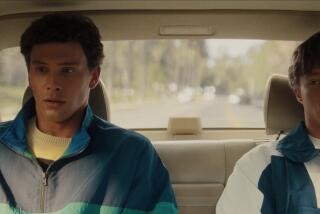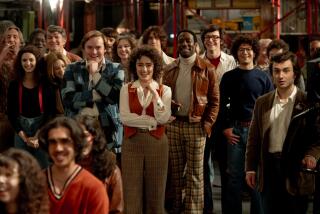Unfortunately, All Wet
- Share via
There’s a word for Gus Van Sant’s colorized version of Alfred Hitchcock’s “Psycho,” a word that so dominates today’s marketing-driven movie culture it probably deserves to be written in capital letters. It’s not sacrilege, not travesty, not profanation or desecration. The word is gimmick.
For though the “creative team” (a phrase that doesn’t often deserve to be in quotes as much as it does here) behind it would have you believe that critics would be offended simply by the notion of redoing “Psycho,” that’s not the case. No film is a holy object, and certainly not those by Hitchcock, a director who blithely remade his own works, believed passionately in being commercial and liked nothing better, he once said, than playing the audience “like an organ.” It’s not a crime against art or nature to do to “Psycho” what Gus Van Sant has done, it’s simply boring, a waste of time and money, and doomed to be the failure it is.
If anything is troubling about this project it’s the charlatanism involved, the attempt, which did not start off impressively at the box office (the opening weekend was $10.5 million), to dupe the public into thinking they’re getting something they’re not. By the same token, what is interesting about “Psycho” is the combination of forces that got it made, forces that neatly encapsulate what carries weight in today’s Hollywood, what levers are most effective in getting things done.
If Gus Van Sant and producer Brian Grazer had simply said they were remaking “Psycho,” the torrent of revenue-generating publicity they received would never have materialized. But calling it a shot-by-shot re-creation of what happens to unsuspecting Marion Crane (Janet Leigh in the original, Anne Heche here) when she checks in at the lonely Bates Motel was a superb piece of marketing, a gambit that gains in brilliance because at best it is only partly true.
Yes, I know, everyone in America has heard by now about the next-door-to-fetishistic care Van Sant took with “Psycho’s” details. The license plate on Marion Crane’s car is the same in both versions, the newspaper she buys is folded the same way, many of the scenes are shot just as Hitchcock did (largely wasting superb cinematographer Chris Doyle), and Van Sant has even hired an actor to impersonate Mr. H in his traditional cameo.
Yet, it hardly needs to be said, Hollywood being Hollywood, that despite the piously professed desire to do everything exactly as Hitchcock did (including no screenings for critics), no one felt constrained to stick to the original $800,000 budget (Grazer and Van Sant have given conflicting interviews on how the new film’s $20-million-plus cost relates to the inflation-adjusted original figure) and no one offered to cut admission prices back to 1960s levels.
Similarly, so many details have been changed, some at whim (why a new house for Norman Bates, why a new neon sign for the motel, why give a murder victim a subliminal flashback?) and some to update things to make the story fit more snugly into the late ‘90s, that the conclusion is unavoidable that the filmmakers have felt free to call the film a re-creation when it suited them and equally free to ignore that dictum when it didn’t.
Most of the updates have to do with giving “Psycho” the last thing it needed: a ‘90s sexual edge. While John Gavin as Marion’s boyfriend Sam Loomis kept his pants on in the original, Viggo Mortensen displays an unclothed rear end here. The soundtrack of his opening meeting with Marion has been altered to add the sound of other couples having sex and, in the biggest departure of all, Vince Vaughn’s Norman Bates is shown unmistakably masturbating while watching Heche’s Marion Crane through his office peep hole.
Other modernizations create problems of their own. The amount of money Marion walks off with has been quite reasonably upped from $40,000 to $400,000, but in order to make that large sum fit in the same size envelope $40,000 did in 1960, it’s shown to be composed of $1,000 bills. Unfortunately, those bills do not freely circulate the way $50s and $100s do, and in fact would never be accepted by the used car lot where Marion spends some of them.
One other change is especially troublesome. In the film’s original black-and-white opening credits, the “written by” citation reads “Joseph Stefano based on the novel by Robert Bloch.” In this version, which Stefano updated, only his name appears in the front credits, with Bloch relegated to a place in the final crawl. It’s never too late, apparently, for Hollywood to disrespect an original author.
Yet, paradoxically, though this “Psycho” is most accurately thought of as a faithful remake, it does stick so close to the 1960 plot that there’s no point in anyone who’s already seen the original to see Van Sant’s version.
“Psycho’s” creative team talks grandly of its film being just like watching a classic piece of theater with a different cast, but unlike most plays that are revived, the dialogue is not, to put it mildly, what made “Psycho” a sensation. As a member of the opening-day audience 38 years ago, I well remember that it was the completely surprising nature of the film’s unusual twists, not what anyone said, that made the experience memorable.
*
So what about audiences who’ve never seen “Psycho” before? Even for those innocents, the obstacles to taking pleasure in the new version are considerable.
For one thing, more than for most genres, the enjoyment of a scary movie is a function of its particular time and place. In 1960, prominent cast members didn’t die a third of the way into a film, cross-dressers were not appearing on trash TV every other week, the sound of a flushing toilet could cause a censorship crisis, and the sight of Janet Leigh with her shirt off in the opening scene added an unnerving frisson to the film that not even total nudity could duplicate today. For today’s younger audiences raised on gore-fests like “Scream,” even the famous shower sequence is like weak tea.
Also, the often-overlooked cast dynamics that helped make “Psycho” successful have proved difficult to re-create. While Janet Leigh had no problem playing Marion straight on, Heche, an otherwise excellent actress, is completely at sea in trying to figure out this typically 1960 woman. And while Anthony Perkins as Norman Bates had a brilliant innocence about him, that’s something Vince Vaughn, who can’t resist tipping his hand with a menacing little laugh, hasn’t come within hailing distance of duplicating.
Given that this masquerade version of “Psycho” really had no chance of satisfying any audience (only Bernard Hermann’s exceptional score works the same way now as it did then, and that is not nearly enough), it took a combination of two of the most unstoppable forces in Hollywood to get it made.
Force One: A creative person with clout (Van Sant, just off the success of “Good Will Hunting”) wanted to do it. To Van Sant, a graduate of the Rhode Island School of Design, the idea of following in the footsteps of Marcel Duchamp and Andy Warhol and doing a riff on a real object is understandably appealing. To him it was a goof, like using (and crediting) one of John Woo’s kitchen knives when the props department could have gotten the same one from a cutlery store. And indulging his art school sensibility probably helped Van Sant to forget the awkward truth that “Good Will,” though it captured America’s heart, was about as aesthetically adventurous as a plain paper cup.
Force Two: One of Hollywood’s smartest producers saw the chance to make something out of nothing. The savvy and market-wise Grazer realized at once that the notion of “Psycho” and its celebrated shower scene was embedded in our cultural consciousness, the same way “Batman” had been before it became a big-screen success story. If the film could be made for a price--which it was--and joined to a hip and clever ad campaign (“Check in. Relax. Take a shower.”), a powerful opening weekend seemed like a safe bet.
Naturally, Van Sant’s “Psycho” ends with an on-screen nod to Alfred Hitchcock, and it’s interesting to speculate what the Master of Suspense would have thought. Turning in his grave would not be an option; if anything, Mr. H’s commercial instincts would lead to a tip of the hat in Grazer’s direction. If Hitchcock actually had to watch the film, his reaction would probably parallel the viewer who said, puzzlement in his voice as Friday’s first show ended, “Why bother?” Why indeed.
More to Read
Only good movies
Get the Indie Focus newsletter, Mark Olsen's weekly guide to the world of cinema.
You may occasionally receive promotional content from the Los Angeles Times.









